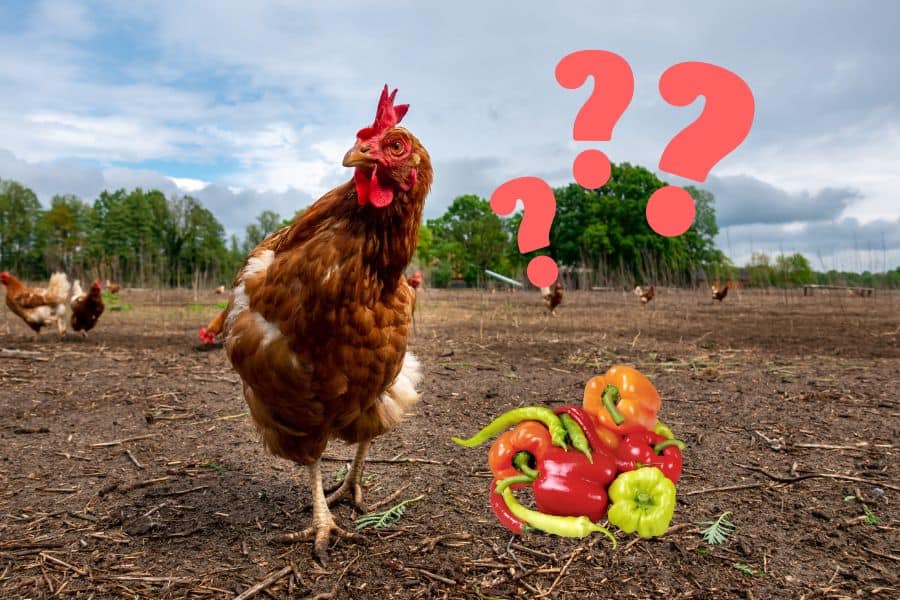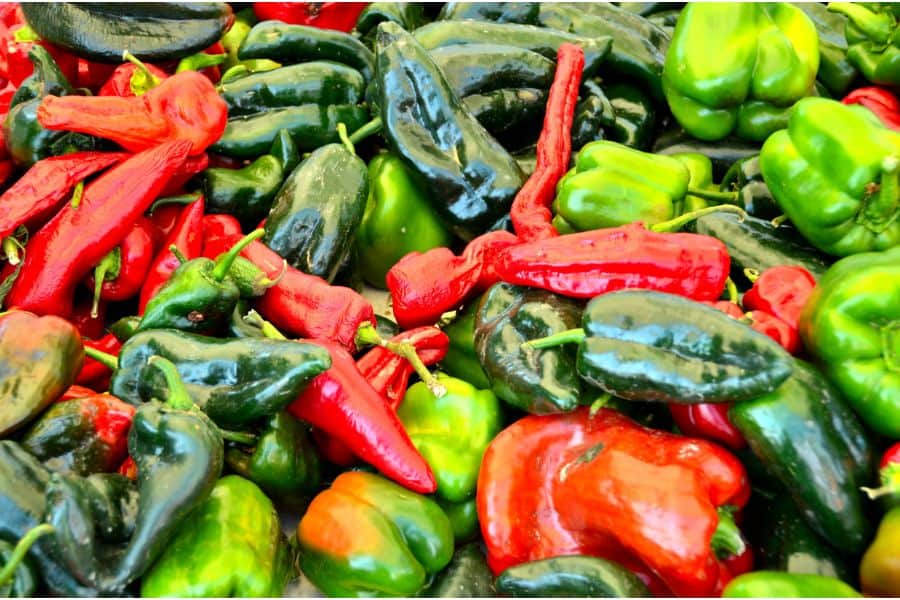Did you know chickens have an easier time eating spicy peppers because they can’t taste the spicy stimuli? What a treat!
This is one of the reasons why chickens enjoy eating pepper seeds and fruits. Chickens also thrive on a pepper supplement diet due to the nutritious benefits that can help improve the color of the yolks and fight bacteria infections.
Despite these benefits, some parts of the pepper plant can be toxic to chickens, causing them to experience symptoms like diarrhea and vomiting.

The good news is that pepper fruits & seeds are not toxic, they can be eaten freely by chickens and have tremendous health benefits.
This article dives into the pepper compound said to harm your chickens and the many benefits feeding chickens pepper can have. Read on to learn how you can properly feed your chickens pepper while still ensuring their health.
Can Chickens Eat Peppers: How Peppers Affect Chicken
Solanine, an alkaloid compound found in vegetables of the nightshade family, is the main reason why peppers are of much concern to farmers.
Solanine can only be found in the flowers, stem, stalk, roots, leaves, and other green parts of the pepper plant; but not in the fruit, core, or seeds.
The compound is a well-known poison that affects many animals including humans and poultry. It affects the gastrointestinal tract of the animals as well as the nervous system. This leads to disrupted motor function, gastrointestinal distress and in some cases respiratory problems.
With this in mind, any nightshade vegetable (tomatoes, eggplants, potatoes) is safe for consumption so long as the chicken is fed the fruits and seeds only. If the chickens eat the flowers, stem, roots, stalk, or leaves, then they are at risk of solanine poisoning which is characterized by diarrhea and vomiting.
That said, it is evident that you can feed any type of pepper to your chicken and they will be fine; whether it is a bell pepper, sweet pepper, red, green, yellow, jalapeno, cayenne, or chili pepper.
Chickens can safely eat pepper so long as it makes up about 5% of their diet. According to one study, ingestion of solanine starts causing symptoms at about 2 to 5 mg/kg of body weight. Fatal amounts that may lead to death start at 3 to 6 mg/kg.
Apart from solanine, pepper also contains capsaicin, a compound that gives pepper its spicy taste.
Many keepers and hobbyists often worry that the spicy food might irritate or cause discomfort if consumed by chickens in large amounts. However, this is far from the truth.
Chickens do not have capsaicin receptors. These are the nervous system components that give mammals the ability to taste the spicy stimuli in many foods and spices.
Chicken and all birds lack these receptors and no matter how much they consume pepper, they will never be affected by their hotness.
Symptoms of Pepper Intoxication in Chicken
While small amounts of solanine are safe for chickens, excessive consumption can lead to visible symptoms in just a matter of 24 hours.
Some of the common symptoms include:
- Diarrhea
- Vomiting
- Other gastrointestinal upset
- Digestive disturbance
- Mild respiratory irritation in high-exposure situations
Benefits of Feeding Peppers to Chickens
Peppers are rich in healthy minerals and antioxidants, which can provide nutritional benefits to chickens. The key lies in moderation and proper preparation. Here are more reasons why you should feed different types of pepper to your chicks:
Bell Peppers
Did you know that fresh raw bell peppers are mainly made up of water, about 92%? Bell peppers, available in various colors such as red, yellow, and orange, are a great addition to a chicken’s diet.
They are packed with essential nutrients, including vitamins A, B6, C, E, and K1. These vitamins contribute to the overall health and immune function of chickens, helping them stay robust and disease-resistant. There also have traces of other nutrients and minerals including folate.
Chili pepper
chilis like cayenne are commonly used among poultry farmers to prevent frostbite in the winter. And, due to their intense colors, they are used to darken the egg yolk colors to make them brighter and more pronounced.
Cayenne, marigold flower, and paprika are some of the other plant additives used in commercial poultry to intensify the color of the eggs in the yolks. Please ensure you do not overdo the red peppers since they are known to give the yolks a pink color.
Cayenne pepper sprinkles also help reduce rodent infestations around the chicken feed, all without harming the hens.
Sweet Peppers
Sweet peppers, like banana peppers and cubanelle peppers, are mild and non-spicy, making them more nutritious for chickens. They also provide a good source of vitamins and minerals, such as vitamin B6, folate, and potassium.
Red Peppers
Red peppers are mature bell peppers and offer additional benefits. They contain higher levels of antioxidants, such as beta-carotene and lycopene, compared to their green counterparts. Antioxidants help neutralize harmful free radicals in the body and promote overall well-being in chickens.
Black Pepper
Black pepper acts as an anti-inflammatory and also improves the respiratory health of the chicken. Chickens commonly suffer from respiratory issues, and adding pepper supplements to the diet can help curb the problem. Black peppers also have high antioxidant content.
Green Peppers
Green peppers are unripe bell peppers and are safe for chickens to consume. They provide essential nutrients like vitamin C and dietary fiber. Vitamin C acts as an antioxidant and supports immune function in chickens, while dietary fiber aids in digestion.
Bell Pepper Seeds
The seeds of bell peppers are safe for chickens to consume and can provide a nutritious snack. They contain small amounts of beneficial oils and minerals.
However, keep in mind that excessive consumption of seeds may contribute to weight gain, so it’s best to offer them as a treat rather than a staple food.
It is important to note that moderation is key when feeding peppers to chickens. While peppers offer various benefits, they should be part of a balanced diet alongside other nutritious foods.
How to Feed Pepper to Chicken
Pick the fruits and seeds, and core alone. This is the first point of focus of properly feeding pepper to chickens.
1. Small Quantities
Prepare the peppers by cutting them in half and exposing the seeds. Chickens prefer the seeds which will also help them get the most out of the satisfying ingredients in the peppers.
Start with small quantities and gradually increase the amount of pepper over time. Take note of how the chickens react to the feed and adjust accordingly.
2. Cook the Pepper
If you see that the hens are having a hard time consuming the food, you can go ahead and cook some of the pepper to compare.
Cooking peppers can enhance their digestibility and reduce any potential digestive issues. The heat breaks down complex fibers, making the nutrients more accessible to the chickens. However, overcooking can lead to nutrient loss, so it is advisable to find a balance to retain the nutritional value while improving digestibility.
Cooked peppers are softer and much easier for many chickens to consume particularly younger ones. However, the preference for cooked to raw chickens will depend on your flock.
3. Select Riper Peppers for More Nutrients
Go for the riper peppers since they are more nutritious and more likely to pique the interest of the chickens.
You can also choose to use the powder (more concentrated) form of paprika and cayenne. Sprinkle the powder into the chicken feed to create a mix of about 1 kg of feed per 1 teaspoon of powder.
4. Mix Peppers onto Warm Oatmeal or Scratch Grains
Make a note not to exceed 5% of the chicken’s diet. Let it act as a supplement to the feed rather than a staple in its diet.
Also Read:
FAQs
Can Chickens Eat Raw Peppers?
Chickens have a unique digestive system that enables them to efficiently process a wide range of foods. When it comes to peppers, chickens can safely consume them in both raw and cooked forms.
You can safely feed raw pepper to chickens so long as you omit any green parts and stick to the fruits, seeds, and core. These parts of the pepper plant do not contain solanine which makes it safe for chicken consumption.
Why Is Red Pepper Good for Chickens?
Did you know that chickens can taste red pepper because of its high sweetness? The pepper’s ripeness can easily be identified by how red or green it is; green is unripe, while yellow is mild, and red is the ripest color of the fruit.
Red pepper is good for chickens since this color change also comes with an increase in nutritional content. This is why the red pepper is the sweetest and healthiest pepper for chickens.
Ripe peppers can also be identified from their fully formed seeds which hens enjoy eating very much. The same cannot be said for the leaves, flowers, or stalks.
What Other Foods Are Toxic to Chickens?
Other foods that chickens cannot eat include:
- Chocolate – it is as poisonous to cats and dogs as it is to chickens. It contains caffeine and theobromine which chickens cannot digest properly, thereby making them poisons.
- Tea – also contains caffeine.
- Candy
- Moldy foods
- Alcohol – chickens cannot easily detoxify from alcohol like human bodies and this leads to quick organic failure.
- Allium plant family – In high doses, allium plants like onions, shallots, chives, garlic, and leeks can lead to anemia due to the effects of sulfide toxins in the plants.
- Avocado – contains Persin which causes damage to the heart tissues in many poultry animals. Symptoms include labored breathing, high heart rate, and myocardial tissue damage.
- Citrus – contains citrus acid that increases calcium digestibility thereby affecting calcium absorption that leads to soft eggshells.
- Dry beans – causes blood clots because of the presence of hemagglutinin
- Potatoes – white and sweet potatoes are healthy for chickens but green potatoes contain solanine which is toxic to chickens.
- Fried foods – chickens do not have enzymes to break down fats easily and quickly.
Conclusion
So, is pepper good for poultry like chickens? Definitely yes.
It is noteworthy to know that according to the MCD Manual (Merck Veterinary Manual), solanine poisoning is not among the common forms of poultry poisoning. Most common poisonings in poultry like chicken includes:
- Aflatoxicosis – The most common type characterized by ataxia, lack of appetite, convulsions, and sometimes death. Commonly caused by eating feed contaminated with Aspergillus flavus, A parasiticus, and others.
- Calcium poisoning form excessive calcium intake
- Ammonia poisoning
- Botulism from a bacterium
- Carbon Monoxide poisoning from fumes during transportation
- Copper Poisoning from plant feeds treated with copper sulfate additives, etc.
This means even though your chickens might suffer from solanine poisoning, you can rest assured that they will not be fatally affected. Keep the peppers as supplements to their diet and ensure they only eat the seeds, core, and fruits.

